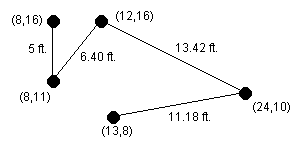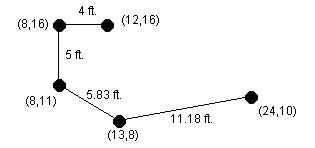
Computer networking requires that the computers in the network be linked.
This problem considers a "linear" network in which the computers are
chained together so that each is connected to exactly two others except
for the two computers on the ends of the chain which are connected to only
one other computer. A picture is shown below. Here the computers are the
black dots and their locations in the network are identified by planar
coordinates (relative to a coordinate system not shown in the picture).
Distances between linked computers in the network are shown in feet.

For various reasons it is desirable to minimize the length of cable used. Your problem is to determine how the computers should be connected into such a chain to minimize the total amount of cable needed. In the installation being constructed, the cabling will run beneath the floor, so the amount of cable used to join 2 adjacent computers on the network will be equal to the distance between the computers plus 16 additional feet of cable to connect from the floor to the computers and provide some slack for ease of installation.
The picture below shows the optimal way of connecting the computers shown
above, and the total length of cable required for this configuration is
(4+16) + (5+16) + (5.83+16) + (11.18+16) = 90.01 feet.

6 5 19 55 28 38 101 28 62 111 84 43 116 5 11 27 84 99 142 81 88 30 95 38 3 132 73 49 86 72 111 0
********************************************************** Network #1 Cable requirement to connect (5,19) to (55,28) is 66.80 feet. Cable requirement to connect (55,28) to (28,62) is 59.42 feet. Cable requirement to connect (28,62) to (38,101) is 56.26 feet. Cable requirement to connect (38,101) to (43,116) is 31.81 feet. Cable requirement to connect (43,116) to (111,84) is 91.15 feet. Number of feet of cable required is 305.45. ********************************************************** Network #2 Cable requirement to connect (11,27) to (88,30) is 93.06 feet. Cable requirement to connect (88,30) to (95,38) is 26.63 feet. Cable requirement to connect (95,38) to (84,99) is 77.98 feet. Cable requirement to connect (84,99) to (142,81) is 76.73 feet. Number of feet of cable required is 274.40. ********************************************************** Network #3 Cable requirement to connect (132,73) to (72,111) is 87.02 feet. Cable requirement to connect (72,111) to (49,86) is 49.97 feet. Number of feet of cable required is 136.99.